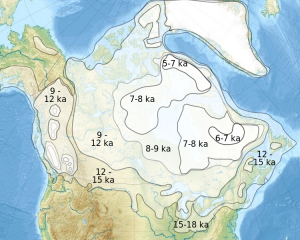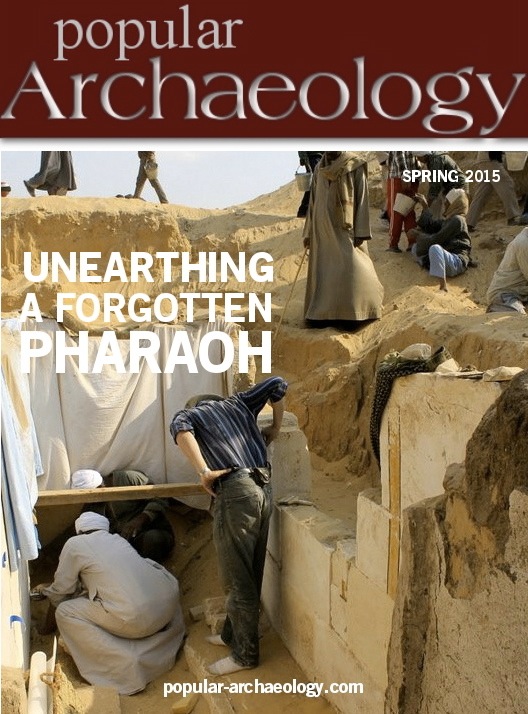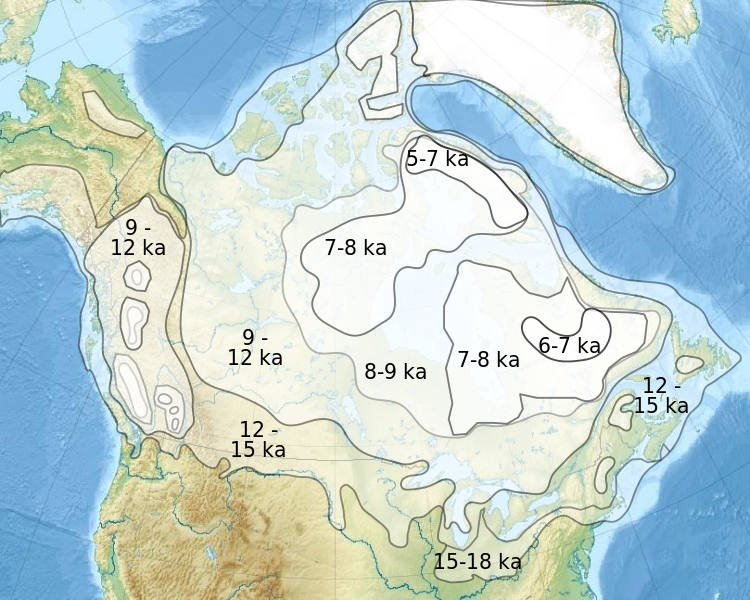
Advanced radiocarbon dating techniques have revealed that a prehistoric kill and butchering site attributed to the Clovis People was active approximately 300 years earlier than previously dated. Animal remains butchered with stone tools near Wally’s Beach, Alberta, Canada, currently represent evidence that prehistoric humans hunted now-extinct horse and camel species near the end of the last Ice Age. The site contains the only known evidence to date for horse and camel hunting in the Americas during that time period.
As documented in a report published in the Proceedings of the National Academy of Sciences*, Michael Waters of Texas A&M University and colleagues from two other institutions re-dated the remains using advanced sample purification techniques. The remains were previously dated to around 13,000 years ago and ascribed to the Clovis People. The authors produced 27 new radiocarbon ages that suggest that Wally’s Beach was active around 13,300 years ago, approximately 300 years before the generally accepted earliest date range for the Clovis culture. The new timeframe, the authors report, allows the Canadian site to be examined in the context of human hunting and the well-documented extinction of numerous large mammal species near the end of the last Ice Age. Added to other North American sites that demonstrate mammoth, mastodon, sloth, and gomphothere hunting, Wally’s Beach suggests that prehistoric humans hunted six of the 36 now-extinct genera of large mammals for at least 2,000 years before the animals vanished from the North American landscape around 12,700 years ago, according to the authors.*
_________________________________________
Map of North America showing stages of Ice Age retreat with associated ages. Wally’s Beach, as an active site, would have been located within the 12 – 15 ka region on the map. T. Kostolany, Wikimedia Commons
_______________________________________________________
*Article #14-20650: “Late Pleistocene horse and camel hunting at the southern margin of the ice-free corridor: Reassessing the age of Wally’s Beach, Canada,” by Michael R. Waters, Thomas W. Stafford, Jr., Brian Kooyman, and L. V. Hills.
Source: Adapted and edited from the PNAS press release, Large mammals hunted by prehistoric humans
_______________________________________________________
 Read about the most fascinating discoveries with a super-saver subscription to Popular Archaeology Magazine. Find out what Popular Archaeology Magazine is all about.
Read about the most fascinating discoveries with a super-saver subscription to Popular Archaeology Magazine. Find out what Popular Archaeology Magazine is all about.
Recently released!
A special new premium quality print edition of Popular Archaeology Magazine. A beautiful volume for the coffee table.
Travel and learn with Far Horizons.
____________________________________________
 Popular Archaeology’s annual Discovery Edition eBook is a selection of the best stories published in Popular Archaeology Magazine in past issues, with an emphasis on some of the most significant, groundbreaking, or fascinating discoveries in the fields of archaeology and paleoanthropology and related fields. At least some of the articles have been updated or revised specifically for the Discovery edition. We can confidently say that there is no other single issue of an archaeology-related magazine, paper print or online, that contains as much major feature article content as this one. The latest issue, volume 2, has just been released. Go to the Discovery edition page for more information.
Popular Archaeology’s annual Discovery Edition eBook is a selection of the best stories published in Popular Archaeology Magazine in past issues, with an emphasis on some of the most significant, groundbreaking, or fascinating discoveries in the fields of archaeology and paleoanthropology and related fields. At least some of the articles have been updated or revised specifically for the Discovery edition. We can confidently say that there is no other single issue of an archaeology-related magazine, paper print or online, that contains as much major feature article content as this one. The latest issue, volume 2, has just been released. Go to the Discovery edition page for more information.







